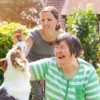Dance therapy, also known as dance/ movement therapy (DMT), emerged in the 1940s as early innovators, began to realize the benefit of using dance and movement as a form of psychotherapy.
Building emotional intelligence can help children foster improved self-awareness and self-regulation skills, which can enhance overall mental health and emotional well-being.
Child and adolescent developmental experts assert that greater emotional intelligence can be developed, especially early in life. Therapy can play an important role in helping children understand and manage their emotions. The American Psychological Association (APA) explain some of the specific ways in which therapy can support children in developing emotional intelligence, such as:
- Emotional identification and labeling: Research hypothesizes that for very young children, it may help to assign a name to their feelings. Therapists can teach children the names of different emotions using age-appropriate language and help them recognize what they are feeling.
- Emotional literacy: Therapists help children grow their emotional vocabulary beyond basic emotions like happy or sad, for example. By introducing more nuanced emotional terms, children can more accurately articulate and express their emotions, leading to a greater understanding of themselves and others.
- Emotion regulation skills: Emotion regulation can be explained as “the ability to exert control over one’s own emotional state.” Therapy equips children with practical strategies (e.g., deep breathing, mindfulness exercises, etc.) to regulate their emotions.
- Validation: Validation within therapy encourages and supports the understanding and acceptance of the child’s experiences, both verbally and nonverbally. Through validation, therapists reinforce the notion that feeling a range of emotions is an integral part of the human experience.
- Emotional exploration: Therapists provide kids with an emotionally safe environment to explore their emotions. This enables children to delve deeper into their feelings, understand their origins, and gain insight into how their emotions influence their thoughts and behaviors.
- Psychoeducation: Therapists educate children about the nature of emotions, their purpose, and how they can inform thoughts and behaviors. Psychoeducation helps children develop a broader understanding of emotions and the role they play in their lives.
- Empathy: Emotion researchers define empathy as “the ability to sense other people’s emotions, coupled with the ability to imagine what someone else might be thinking or feeling.” Through therapy children are encouraged to explore different points of view and gain a deeper understanding of the emotions of those around them.
Emotional intelligence is related to many important outcomes for children, as empirical evidence suggests that children with higher emotional intelligence are better able to pay attention, are more engaged in school, have more positive relationships, are more empathic, and cultivate a greater aptitude for interacting effectively with others.
Further Information and Support
For most of us, life can be very stressful, leading us to feel emotionally charged, which can cause anxiety, panic attacks, depression, and getting stuck in a cycle of being burdened with negative thoughts. Navigating through the challenges and emotional turmoil of life can be overwhelming, but you do not have to go through it alone. Engage Treatment is a Joint Commission Accredited professional psychological practice. We specialize in treating children, teens, and young adults struggling with depression and anxiety through community-focused treatment plans that incorporate a carefully selected combination of therapeutic interventions. Our compassionate, multidisciplinary practitioners are devoted to providing the highest quality of care that helps ignite positive change and enables clients to reach optimal health and well-being. Please do not hesitate to reach out for guidance. We are happy to answer questions and provide you with any additional information. Feel free to call us at 805-497-0605 or email us at [email protected]. You are also welcomed to get in touch by filling out our contact form. We look forward to connecting and having the opportunity to discuss how we might best be able to support you.
Contact Us
Westlake Campus:
IOP Program
2625 Townsgate Road, Suite 210
Westlake Village, California 91361
Agoura Campus:
Private Therapy & Parenting Program
30300 Agoura Road, Suite 250
Agoura Hills, CA 91301
805-497-0605
805-371-4862











© 2023 Engage Treatment Program, Inc. All Rights Reserved.
LGBTQ Friendly
About
• About Engage
• Our Team
• Career Opportunities
• Individual / Family Therapy






